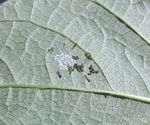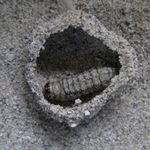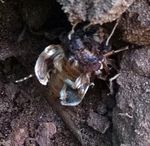Western Bean Cutworm - Field Crop News
←
→
Page content transcription
If your browser does not render page correctly, please read the page content below
Western Bean Cutworm
Scouting and Management in Dry Beans
Tracey Baute, OMAFRA-Ridgetown
Meghan Moran, OMAFRA–Stratford
Chris Gillard, University of Guelph Ridgetown Campus
Emerging Pest of Dry Beans in Ontario Eggs are laid in masses of 5-200 eggs, typically on the under-
Native to North America, western bean cutworm, Striacosta side of dry bean leaves, deep in the crop canopy. Eggs are the
albicosta had been a long-time resident of the U.S. Great Plains size of a pin head, pearly white when fresh and are shaped like
region until it began expanding its range eastward and was de- tiny cantaloupes (Fig. 3). They take 5-7 days to hatch, gradually
tected in Ontario in 2008. Over the last 10 years, overwintering darkening to tan and then purple, within 1-3 days before
populations have now established across Ontario and is now hatching.
considered the primary pest of corn in Ontario. Damage in dry
beans first appeared in 2014 and has been found in most dry Damage
bean growing areas of Ontario, indicating that it is becoming a Feeding damage in dry beans begins as tiny shot holes in leaves
new emerging and important pest for this crop. and flower petals by the very young larvae (Fig. 4). Once larvae
reach the third instar, they move to feeding on and within the
Identification pods. These older larvae only feed at night, spending the day in
Despite its name, western bean cutworm (WBC) is a pest of and on the soil surface. Each night, larvae climb up the plant
corn (field, sweet and seed) as well as dry bean. Unlike other to feed on a new pod and exit again before morning. Entry
cutworms, this pest feeds on the fruit of the plant, i.e., corn holes can be seen on the outside of the pod (Fig. 5).
ears and bean pods. WBC moths have a white band along the
margin of each wing and each wing has a “full moon” and Seeds can be shriveled or damaged from direct feeding. Yield
boomerang-like mark (Fig. 1). loss from direct bean feeding is less of a concern than quality
issues caused by this feeding. The holes allow for the introduc-
Newly hatched WBC larvae have dark heads and spots along tion of pod diseases, which in turn impact seed quality. Dam-
their bodies, somewhat resembling European corn borer. Once aged bean seed is further docked as “pick” requiring additional
in the third instar stage, their heads lighten and bodies change screening and cleaning (Fig. 6). Beans exposed to air from
to a tan-pink colour, with subtle longitudinal stripes. Once in WBC holes can discolour, particularly in cranberry beans.
the final fifth and sixth instars, two distinctive broad dark
brown stripes develop behind their head (Fig. 2).
1 2 3
4 5 6
Figures 1-6. From top left to bottom right– 1. WBC adult moth. Photo credit: Jocelyn Smith, UGRC; 2— WBC larva. Photo Credit:
Tracey Baute, OMAFRA; 3– Freshly laid WBC eggs on corn. Photo Credit: Tracey Baute, OMAFRA; 4—WBC leaf feeding damage
on beans. Photo Credit—Chris DiFonzo, Michigan State University; 5—WBC pod feeding damage. Photo Credit—Jocelyn Smith,
UGRC; and 6—WBC seed damage. Photo Credit—Chris DiFonzo, Michigan State University
Revised April 2020 Page 1The WBC Life Cycle Once corn fields in the area are past the early tassel stages,
moths prefer to lay their eggs in dry bean fields or late planted
Western bean cutworm complete one generation per year (Fig. corn fields (E). Eggs in dry bean fields are laid on the underside
7). Through fall to early summer, pre-pupae lie dormant in soil of the leaves, deep in the crop canopy. Eggs take five to seven
chambers until spring when they pupate (A). Moths climb out days to hatch, starting as pearly white when fresh, turning a
of the soil in early July in Ontario (B) though migratory moths purple colour within a few days of hatching (E-F). Egg laying
from nearby states (eg. Michigan) can be captured in traps in can occur in Ontario anytime from mid-June to the end of Au-
Ontario as early as the first week of June (C). Average peak gust.
moth flight in Ontario occurs during the last week of July,
though this timing varies regionally. Southern-most counties Once the eggs hatch (F), the tiny larvae consume their egg shell
tend to peak in the second week of July, while eastern counties then feed briefly on the bean leaves and flowers until 3rd in-
do not experience peak flight until the first or second week of stars (G). They then spend most of the day in the soil surface.
August. At night, the larvae crawl up a bean plant, feeding on a new
bean pod each night (H). They continue this until the bean
Moths are mostly active at night. Mated females are preferen- pods are ready for harvest (I). The larvae then drop to the
tially attracted to late whorl to early-tassel stage corn to lay their ground to burrow down and enter the pre-pupal stage in the
eggs on the top two or three leaves of the corn plants (D). fall (J).
C E
D
B
Late July & August F
Pre-tassel to Early
June & July Pollination
A
1 Generation/ G
Year
Fall—Late Spring
J I
August & September H
Figure 7. Life cycle of western bean cutworm in dry beans in Ontario.
Photo Credits: Jocelyn Smith, UGRC for A, C and J; Tracey Baute, OMAFRA for D and H; Jennifer Bruggeman, UGRC for E and F and
Chris DiFonzo, Michigan State University for G and I.
Revised April 2020 Page 2Scouting Guidelines for Dry Beans bucket part of the trap. Some prefer to tape them to the side
so they don’t fall out while counting moths each week. One
Pheromone Trapping vapour strip will last for approximately 2 months.
Pheromone traps are used to monitor moth activity and detect
when peak flight occurs. Traps also determine if WBC are Each trap will need four WBC pheromone lures per season,
active outside of the known hotspots in Ontario. Trap counts and 1-2 insecticide vapour strips per season. Lures must be
are not used to determine when to spray, but identify fields at stored in the freezer when not being used. Change the lure in
risk and when scouting is required. Average peak flight in On- the trap every 3 weeks. Discard old lures off site away from
tario typically occurs in the last week of July but varies by re- the trap. Use gloves when handling the lures and vapour
gion (Fig. 8). Peak egg laying follows shortly after peak flight. strips. Trap supplies can be purchased at a number of supply
Traps should be monitored at least weekly in early July until companies listed on the Great Lakes and Maritimes Pest Mon-
late August. As peak flight approaches, plan to monitor the itoring Network tab on the Field Crop News website.
traps more frequently so that there are fewer moths to count
at one time and the moths are less likely to be deteriorated and Trap participants are encouraged to join the Great Lakes and
difficult to identify. Maritimes Pest Monitoring Network and provide their weekly
trap counts during the season. In return, interactive maps and
user dashboards are created to help identify those areas at risk
that require scouting: https://arcg.is/0aWqr0
Scouting
WBC displays different behaviour in dry beans than in corn.
Unlike in corn, WBC are nearly impossible to find in dry bean
fields until pod feeding begins. Fortunately, since WBC exit
and enter new pods each night, foliar insecticides are still quite
effective at controlling the larvae if used when early signs of
pod feeding are observed.
Figure 8. Peak WBC Moth Flight by Region in 2019. Peak flight A C
was delayed in 2019 with peak occurring the 4th week of July
(Week 10) in the southwestern counties, while central and east-
ern Ontario did not peak until the second and third week of Au-
gust (Week 11 and 12). Flight was also prolonged with moths
still actively flying the first week of September.
Green bucket or universal traps (uni-traps) are the preferred
traps to use for monitoring WBC (Fig. 9). Each dry bean site
requires two traps per field. Mount each trap to hang from a
stake four feet (1.2 metres) above B
the ground. Place each trap on op-
posite sides of the field, with one of
them along the prevailing wind side
to carry the pheromone plume into
the field to give a better indication
of moth activity for that field. The
traps can be within the first few
rows of the beans or along the
field’s edge above low lying weeds.
One pheromone lure is placed in- Figure 10. Signs of feeding by young WBC. Young larvae may
side the small cage area suspended feed on flowers (A) or graze on the surface of the pod (B). Older,
from the trap roof. One insecticidal larger larvae are able to mine directly into the pod (C) Photo
Credit: Chris DiFonzo, MSU (A); Tracey Baute, OMAFRA (B); Jim
vapour strip is placed inside the
Barclay, Hensall Co-op (C).
Figure 9. All green bucket traps used for WBC monitoring.
Photo credit: Jen Bruggeman. Pheromone traps help indicate which fields are at greater risk.
Revised April 2020 Page 3Traps at dry bean fields that capture an accumulation of 50 or Other WBC Resources
more moths/trap are likely at greater risk and require scouting Great Lakes and Maritimes Pest Monitoring Network:
for pod feeding. https://fieldcropnews.com/2020/04/2020-great-lakes-and-maritimes-
pest-monitoring-network/
Pod feeding is expected to begin 10 to 20 days after peak moth
flight has occurred, as indicated when trap counts begin to de- WBC Trapping Instructions and Resources:
cline after weeks of steady increase. Prior to pods being present https://fieldcropnews.com/wp-content/uploads/2020/04/2020-WBC
-Trap-Set-Up-and-Monitoring-Instructions.pdf
on the plants, scouting for egg masses in adjacent cornfields can
also help determine what the local WBC populations are like. If WBC Biology and Management Information:
any of the corn fields in the immediate area are past early tassel-
Ecology and Management of the WBC in Corn and Dry
ing, the dry bean fields will be more attractive for the moths. If
Beans—Revision With Focus on the Great Lakes Region
an adjacent corn field reached the corn egg mass threshold and
(Journal of IPM– free online):
required spraying, the dry bean field is also likely at risk. https://academic.oup.com/jipm/article/10/1/27/5558144
Action Threshold for Dry Beans
Pest Manager:
Thresholds are currently not available for WBC in the Ontario
http://gfo.ca/apps
dry bean crop. Trapping thresholds established in western U.S.
have not been found to be effective for dry beans grown in the
OMAFRA Publication 811, Agronomy Guide for Field
Great Lakes region. It is best to focus on determining when
Crops:
peak flight has occurred in the area and focus efforts on scout-
http://www.omafra.gov.on.ca/english/crops/
ing for signs of pod feeding and management 10 to 20 days after
pub811/13corn.htm#wbcutworm
peak flight.
OMAFRA Publication 812, Field Crop Protection Guide
Research indicates that control is still very effective when done
for Field Crops:
shortly after pod feeding is found. A dry edible bean field that is
http://www.omafra.gov.on.ca/english/crops/pub812/
adjacent to a corn field that has reached threshold for WBC will
p812toc.html
likely need to be sprayed once pods are present and pod feeding
is found (approx. 10 to 20 days after peak flight).
In-Season Activity and Alerts:
Spraying too early when pods are not present on the plants will
not protect the crop from damage. Spraying too late, when pod
Field Crop News/Baute Bug Blog
feeding has been taking place for some time will not reduce the
http://fieldcropnews.com/category/bautebugblog/
risk of seed damage and disease incidence. The key is to protect
the plants when the larvae are feeding on the young pods.
Twitter Feeds
Management Strategies
@TraceyBaute
@megnmoran
• To reduce the risk of resistance, rotate between chemical @Jocelynlsmith
families each year.
• Several insecticides are registered for WBC control on the
dry beans. Select insecticides that have some residual and Any further questions can be directed to:
pay attention to pre-harvest intervals. Tracey Baute
• Spot treatments may be effective if injury is concentrated in Entomologist—Field Crop
one area of the field. Ontario Ministry of Agriculture, Food & Rural Affairs
• Follow label restrictions regarding application timings to 120 Main Street East Ridgetown, Ontario N0P 2C0
protect pollinators. Avoid spraying insecticides in flowering T: 519-360-7817
fields during the daylight hours when bees are in flight. E: tracey.baute@ontario.ca
• Follow buffer zone requirements to minimize spray drift in
pollinator and beneficial habitats.
• Deep tillage can help disturb and kill larvae overwintering in
soil chambers, though is unlikely to significantly reduce pop-
ulations. Larvae can be at different depths in the soil and the
negative impact of tillage may outweigh the benefits. Moths
also fly into Ontario from other regions which can negate
attempts to supress local overwintering populations.
• Several natural enemies feed on egg masses and young lar-
vae, including lady beetles, lacewing larvae and others.
Revised April 2020 Page 4You can also read



























































